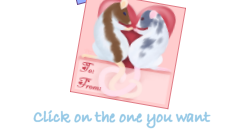|
1
cup whole wheat flour
3/4 cup cornmeal
2/3 cup choped dried mixed fruit (no citrus)
1 teaspoon vegetable oil
1/2 cup apple juice (or some other
non citrus fruit juice)
Mix
all ingredients. Shape mixture into
small (1/2 inch) balls. Place balls on greased cookie sheet.
Bake at 250 F (120 C) for 45 minutes.
After 45 minutes, turn oven off and let treat balls cool completely.
They should be nice and crunchy once cool.
Store in a sealed bag or container in a cool dry place. These treats, in moderation, would also be
suitable for other small rodents such as hamsters, gerbils, and mice.
You might want to make a smaller recipe and slightly smaller treats
(reducing baking time by a few minutes as well) for smaller rodents.
|
 STORY BY
ALIAS
STORY BY
ALIAS
Many people have fish, rodents or lizards of
some sort, but many don’t know the proper size of cage that these
little critters need. Some people get cages that are too big, or too
small. Caged animals are not that hard to find environments for, but it
becomes a challenge when you don’t know what to look for size wise.
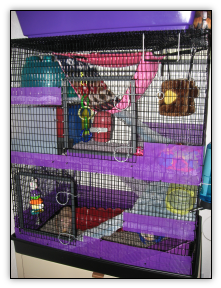
Fish are another story,
though. Since I’ve mainly had Bettas, I will be
using them as my example. Bettas are small fish and usually kept alone.
Male Bettas are the most
|
popular, as they have the beautiful colors.
They can live comfortably in a
flower vase, a small bowl, or even the
cup you get them in from the fish store. Many people choose to add
small rocks to the bottom of such items and keep the fish as a
decoration. Since most male Bettas are not active swimmers in their
bowls, preferring to stare through the glass and wait for potential
opponents; they don’t need a lot of space to swim.
The size of a lizards’
cage really depends on what you are going to be
keeping, and how many you will have. Typically a medium sized lizard
(think Leopard Geckos), doesn’t need more than 40 gallons of space.
However, there are many sizes of cage that come smaller and more
compact with more room to decorate with things that will let them climb
and get their exercise. My own two lizards, who are 9inches and 7
inches, live in a 50 gallon tank with faux rock walling and some room
to crawl around of the flooring. They are provided with wood to climb
since they don’t have a lot of room on the substrate. Some reptile
people will get special cages that allow their reptiles to get an open
air breeze. These are typically made out of screening and plastic and
can be quite cheap depending on size.
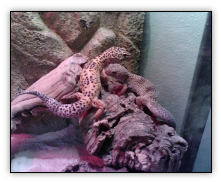
|
|
|
|
|
Along with meat pies, Vegemite, pubs and sausage
rolls, Australian Stock Horses have become an icon and a part of Aussie
culture. Recognized for their toughness, type, temperament and ability
to excel at whatever task they are asked to do they have been accepted
world-wide. This is a little about “The Boss” one of the first
stallions registered with the Stock Horse Society, his blood runs
through some of our best modern day horses and he is still remembered
many years later he’s also the best I have known. Some of this story I
was told, some I was privileged enough to see.
I was lucky enough to be
there from the beginning of the Stock Horse
Society as my surrogate mother/grandmother Molly, helped drag me
kicking and screaming through adolescence and into adulthood was one of
the founders. Molly McLean was an icon in her own right having managed
one of Australia’s largest cattle stations along with her husband
(Victoria River Downs) for many years, at that time you could be
isolated for months in the wet season, the only power came from a
diesel generators when they decided to work, the telephone was the
radio which you could talk on once a day and everyone had to be a jack
of all trades, from mechanic and horse breaker to doctor and cook. To
say she was tough is an understatement, at a whole 5 ft and built like
a string bean she would have many a stock man shaking in their boots
when she entered a room. She worked hard and played twice as hard and
reveled in the fact she could match it with any man and 90% of the time
leave them in her wake. She was the first to hit the dance floor at the
bush races and the last to leave, she could tell as good a yarn around
a campfire and turn the air blue with her cursing as well as any a man
and could drink most under the table. She was a great woman.
Molly first set eyes on Boss
when he was drafted from a mob of brumbies
being culled from the outback in the Northern Territory and destined
for the dogger’s. Molly first saw him at the trucking yards in
Katherine. In those days you could try a brumby for free, if he turned
out ok you paid the going price of $40 if he didn’t you just returned
him to the yards when the next semi of horses destined for Alice
Springs and the rail head left a few weeks later. Commonly known as
drought foals due to the times being so dry, (he had never seen or felt
rain) he and the other herd members were not a pretty sight, he looked
more like a weanling than the two year old he was, pretty plain in type
and colour, dark brown with two white hind socks, a star, a thin blaze
and snip. Breeding wise the mob he came from he was a typical brumby, a
touch of Arab, a smidgen of draft, a splash of thoroughbred and a good
deal of the old Waler type which were mostly of Spanish and Timor
origins with a lot of thoroughbred. As well as being weedy he was very
wild having never had contact with man until the previous few days and
that was definitely not a pleasant experience. Molly saw something in
this horse that no one else had she paid the $40 up front and little
horse was put onto a cattle truck and sent back to the station.
As the station was a lot
further north than where the
little horse was
born everything stopped for the wet season, according to Molly, the
first time it rained
|
the little horse nearly went mad, and half scared
him to death.
Molly now had 3 or 4 months where there was nothing to do
because of the wet so he got quite a bit of attention. Life changed
drastically for the little brown colt,
he was given a yard of his own
near the homestead and with 3 feeds a day. It didn’t take long for him
to start to shoot up and Molly spent as much of her spare time with him
as she could. He soon started to lose the wild streak but still let
everyone know that he also had a mind of his own. It took no time at
all to start being called The Boss a name which he carried all his
life.
When the dry season
arrived a few months later it was time for boss to
start to do some work and earn his keep, he had shot up over the wet
season and was now about 15.hh, big enough to break in and head out for
a season mustering. Horses in the bush are broken in very quickly, in a
matter of days they are sent out on musters, they are very green but by
the time they return home 3 months later very well educated. The first
few days are fun to watch though with jackaroos’ going left right and
center as they get on these half broke horses every morning.
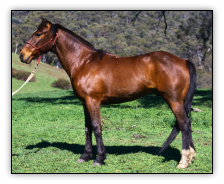
A few years after this
Molly retired and moved to a property in Alice
Springs with her husband, that was where I first met her, the
circumstances of our first meeting which weren’t the best, is a whole
other story. I had left home at an early age, was pretty wild and semi
homeless and was running riot, for some unknown reason along with a
racehorse trainer friend of hers and his wife they decided to take me
under their wing, no easy feat for a 65 year old woman and something I
give thanks for to this day.
The Boss by this time
had developed into stunning horse and had matured
out at 15.2hh not huge but he had a heart as big as Pharlap’s. The
dirty brown colour he had been when Molly first laid eyes on him had
changed to a deep rich mahogany. He was solid but not coarse with a
good strong head, neck and shoulder, his back was short and broad and
he had a hind quarter that was all
|
muscle, he oozed quality. With Molly
he was the best mannered horse you
would ever find, butter wouldn’t
melt in his mouth. With me it was a totally different story, he would
nip me, chase me out of the yard when I tried to clean it and wave his
front legs around at me if I tried to catch him, if I rode him he would
always spook and pig root, all in all a real horror. I am sure on
looking back that he knew I was a rebel and was telling me in his own
way there was only room for one king pin and that was him. As the years
went on I worked out who was boss and our relationship became slightly
warmer. He taught me respect.
In the early 1970’s a
group of people including Molly got together to
try to stop the disappearance of the “Waler”, this horse was bred
mainly soldiers in the Indian mutiny , the Boer war and the first world
war and since then had been basically forgotten about, most having been
released when no longer needed and mixed with the brumbies. After much
discussion it was decided that a breed would be formed and the name
given was “The Australian Stock Horse “. Classifiers were appointed to
each state to test horses wishing to be entered into the stud book.
They had to pass strict conformation and working tests , from memory
height restrictions were very liberal, from 14.2hh to 16.2hh and all
breeds were eligible initially to be included if they passed the
stringent tests. Molly along with her husband were the two classifiers
for the Northern Territory, Two classifiers were brought up from
Queensland to test Boss , some mares, and classify a few of Boss’s
foals. The classifiers were amazed at the quality of the Boss and his
offspring, stating that he was the benchmark of what they hoped to
achieve with the breed.
At the age of 70 Molly
and The Boss decided to take up a quieter sport
and started to train in dressage, within two years they were
representing the N.T. in the National Dressage Championships in
Adelaide at medium level, they didn’t win but were in the top 10 in the
country which again was nothing to sneeze at. I had picked up the
jumping bug by this stage and started to jump Boss under Molly’s
supervision at the local jump club, we went on and jumped in our local
shows doing fairly well until one year molly loaded us all up to do the
northern show circuit (four shows held over a month and a 2000klm round
trip) The boss won Supreme Stock Horse at each show, he won the
dressage with Molly on him at 3 out of the 4 shows, carted me around
the jumping courses winning and placing and competed in the camp drafts
with a stock man from up north.
The Boss led a full and
long life, stamping his foals with the same
class that he himself showed and showing time and again the
characteristics that the Stock Horse is renowned for.
Molly also lived to a ripe old age, only passing on a few years ago,
she would still give me a quick clip under the ear right up to the day
she went, it always amazed me how she could reach that high with such
force so quickly, my ear still burns every time I think of it and her
eyes still burned with the fire I am sure she showed as a young woman
right to the end. Both she and the Boss changed my life and for that I
am eternally grateful, as long as I and a lot of other people live
their story will never be forgotten just embellished with time. |
|
|
 STORY BY
JELLY
STORY BY
JELLY
The Basenji is a hound breed that has been
associated with man since before the Pyramids were built. Also known as
the African Bark-less Dog or Egyptian Dingo, the breed was named after
an African word meaning 'bush thing'. Graceful, independent and highly
intelligent are just a few of the words that come into mind when one
thinks of the Basenji.
The Basenji is one of the
most ancient dog breeds. They originate on
the continent of Africa, and have lived with humans for thousands of
years. It appears these dogs played an important part in life of the
Ancient Egyptians, and have been depicted in their memorial tablets and
statues, as early as the period 1080-332BC.
Europeans first discovered
Basenjis in the Congo in 1895. The breed was
established in England in 1939 after many years of trying. The American
Kennel Club officially accepted the Basenji in 1943. The breed arrived
in Australia in 1946, however gained popularity in the 1970s.
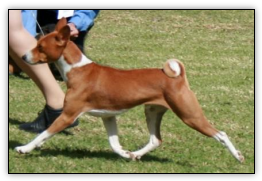
Owned by Tamsala Basenjis
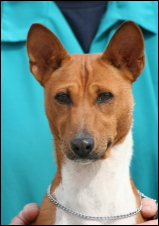 Being a sight-hound, Basenjis
are independent hunters and if used to
hunt, they run and search while man follows to see what the dog finds.
While Basenjis may seem the
perfect dog (small, odorless and
bark-less), they are hounds and highly intelligent. If they are not
well socialized (with other breeds of dogs, as well as people) as a
pup, then they can be aggressive to other animals and suspicious of
strangers. They need lots of stimulation and exercise. The lack of it
may result in a highly destructive escape-artist with little regard for
boundaries.
Being highly independent, they can
be difficult to train. Majority tend
to be very food orientated a trait which can be exploited when
training.
Basenjis are most definitely
not normal dogs. They share quite a few
cat traits, and not just in their grooming habits. They can have the
arrogance and independence of a Siamese, and the nuttiness of a
Burmese. Not to mention the massive dislike for getting wet . . . it’s
amazing to time a Basenji as to how long they can go, without needing
to go toilet.
Basenjis make playful, curious and affectionate pets. They tend to form
strong bonds with their owners. There is never a dull moment when
working with Basenjis. They take great delight in making messes,
teasing you to play, and then entertaining you for hours on end. Being a sight-hound, Basenjis
are independent hunters and if used to
hunt, they run and search while man follows to see what the dog finds.
While Basenjis may seem the
perfect dog (small, odorless and
bark-less), they are hounds and highly intelligent. If they are not
well socialized (with other breeds of dogs, as well as people) as a
pup, then they can be aggressive to other animals and suspicious of
strangers. They need lots of stimulation and exercise. The lack of it
may result in a highly destructive escape-artist with little regard for
boundaries.
Being highly independent, they can
be difficult to train. Majority tend
to be very food orientated a trait which can be exploited when
training.
Basenjis are most definitely
not normal dogs. They share quite a few
cat traits, and not just in their grooming habits. They can have the
arrogance and independence of a Siamese, and the nuttiness of a
Burmese. Not to mention the massive dislike for getting wet . . . it’s
amazing to time a Basenji as to how long they can go, without needing
to go toilet.
Basenjis make playful, curious and affectionate pets. They tend to form
strong bonds with their owners. There is never a dull moment when
working with Basenjis. They take great delight in making messes,
teasing you to play, and then entertaining you for hours on end.
6 ounce can of tuna
1/4 cup water drained from
tuna
3 T cooked egg white, chopped
1/4 cup cornmeal
1/2 cup whole wheat flour
Preheat oven to 350 degrees. Combine tuna, egg white and water. Add
cornmeal and flour and blend to form a dough. Knead into a ball and
roll to 1/4 inch thick. Cut into one-inch sized pieces. Bake at 350 F
for 20 minutes. Makes 12 cookies.
|
 RESEARCHED
BY TALA OF BLACK MAGICK
RESEARCHED
BY TALA OF BLACK MAGICK
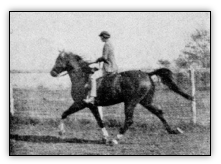 Bazleyd (AHR*648) at Rack, Rider not
identified; source unknown
Bazleyd (AHR*648) at Rack, Rider not
identified; source unknown
Despite this being the abridged version,
there are a few things I would
like to make clear before going on. When using the term “at gait” or
“gaited,” I am referring to gaits besides the more commonly known walk,
trot, canter, gallop and their various speeds, these are also known as
“easy gaits” and the horses that utilize them are often known as “easy
gaited horses.” The gaits mentioned in this article are the rack and
fox trot, both of which the reader would benefit from learning more
about on related websites at the end of this article. The amble is also
mentioned,
and the reader must consider that at the time it was used to describe
most any peculiar, irregular gait, including but not limited to: the
slow racking gait, general racking gait, and sometimes fast paced rack.
It is also important to note that the Arabian at gait should
not be mistaken for the Arabian Park horse, which is a
specialized horse at trot. A flashy, naturally animated trot, but a
two-beat gait nonetheless. The hallmark of an easy gait, is that under
no circumstances should the rider feel the need to post, in fact, there
is nothing to post to. While the gaited (many are
dually referred to as “5-gaited” to show they have a significant extra
gait) Arabians are able to trot, not all trotting Arabians are
predisposed to gait. In the past, the gaiting Arabian was a novelty as
well as a serious competitor, just as it is today. And no less rare or
untapped.
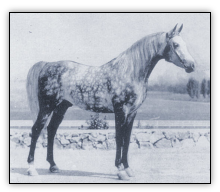 *Raseyn (AHR *597) posed, age unknown;
Photo courtesy of Arabian Stud Book Volume IV, 1937
*Raseyn (AHR *597) posed, age unknown;
Photo courtesy of Arabian Stud Book Volume IV, 1937
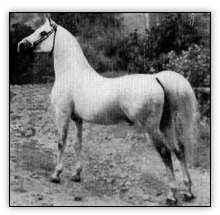 *Raffles (AHR*952) at pose, age
unknown; source unknown
*Raffles (AHR*952) at pose, age
unknown; source unknown
|
*Raffles, like *Raseyn, was a stallion sired by Skowronek and out of
the mare Rifala. Raffles was a gift from Lady Wentworth to Mr. Selby
along with his purchase of various Crabbet Arabians, thrown in not
because of lack of quality, of which he had, but because he had been
determined sterile. With careful diet and distressing programs (using
gentle techniques practically unheard of at the time), Raffles was able
to settle mares. His get were considered in his image, but larger. His
show career was admirable, being named 1933 Three-Gaited Champion at
the National Arabian Horse Show in Nashville, Tennessee. His career was
focused on the breeding shed, classic type, and trotting career. It is
only briefly mentioned that his natural high action was also shaped
into an amble (the gait is unidentified, but one can assume it was a
high actioned rack, or a fox trot which is the easiest gait to
encourage).
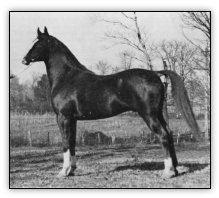 Bazleyd (AHR*648) at pose, age unknown;
source unknown
Bazleyd (AHR*648) at pose, age unknown;
source unknown
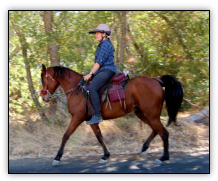 Feather at fox trot; Ellen Robinson up;
source Ellen Robinson photographed by Mr. Robinson
Feather at fox trot; Ellen Robinson up;
source Ellen Robinson photographed by Mr. Robinson
An official website is being set up,
including an unabridged
edition of The Versatile Arabian. If you have a question or comment,
please contact TheVersatileArabian@gmail.com
Resources:
http://www.gaitedhorses.net/Articles/Rack/RackingGait.shtml
http://gaitedhorses.net/Articles/FoxT/FoxTrot.shtml
http://www.gaitedhorses.net/Special.htm
http://www.gaitedhorses.net/GHArticles.html |
|
|
|
 |

|
|









 Being a sight-hound, Basenjis
are independent hunters and if used to
hunt, they run and search while man follows to see what the dog finds.
Being a sight-hound, Basenjis
are independent hunters and if used to
hunt, they run and search while man follows to see what the dog finds. 







